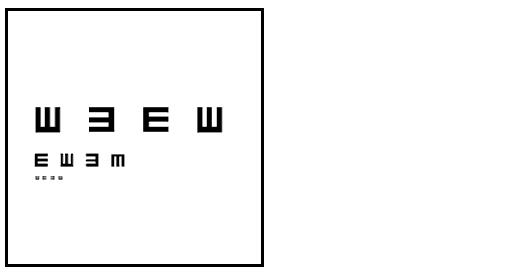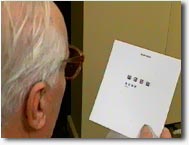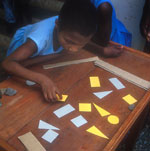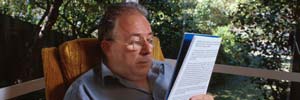
|
|
Objectives
Near Visual Acuity
The purpose in testing near vision is to determine how people can cope with near tasks. If they need some changes to the task or the environment, or if spectacles or low vision devices would be useful.
The results of a near vision test show a person's ability to see the details of near objects (within arm's distance from the body). The results of the test will give an idea of the detail that can be discriminated. Near tasks include craft and leisure activities, eating, personal care and hygiene, some work tasks and reading.
The information from a test of near vision can help in making decisions about whether normal print, large print, low vision devices or Braille will be best for a person. The results of the near vision test are not the only information needed to make such a decision.
Other factors which can affect this decision are reading speed, tiredness (fatigue) from reading, availability of spectacles and low vision devices, and availability of print or Braille materials. Distance visual acuity should not be used to decide on the best type of reading material.
The near vision test needs concentration for only a short time. Some tasks may require concentration on near objects for a long time. This may cause tiredness (fatigue). Fatigue can affect vision. Larger objects, low vision devices or print may be needed to prevent a person from becoming tired from concentrating on a near task.
2,904KB
The test card is held at the distance preferred by the person. Young children may see better when the card is held close to the eyes. The test is performed with spectacles on if they are normally used.The smallest size able to be read correctly is recorded. The distance the card is held from the eyes is also measured and recorded.
Simulation 
Help Assessing Knowledge and Attitude to Vision
Tell the person and family the results of the vision assessment. Is vision within the normal range, that is distance vision 6/18 or better, or is the person able to see the smallest symbols on the near vision test card?
Does the person have poor but usable vision? Explain the effects of poor near and distance vision in relation to the activities that normally take place in the community. What are the important effects on activities such as finding food or water, finding the way around the village or learning from watching other people?
If necessary also explain the implications of a restricted visual field, the effects on contrast, colour vision and night vision.
Suggest ways that visual functioning can be improved:
- working in the best light
- moving closer to objects to see them better
- using objects with good contrast
- allowing plenty of time for looking
More information on Assessing Knowledge and Attitude to Vision
Encourage the use of vision to be aware of what is happening and to find people or objects. Attract and direct the person's attention to watch activities.
Don't always place objects in the person's hand. The person should be encouraged to look for the object and reach out for it.
Use vision with other senses, for example, listen for what is happening to find where to look. Use touch to feel whole object, then look at parts.
Show how the use of contrast and knowing the position of objects can be used to help the person move safely around the community.
More information on Obtaining Information
Ask sighted people to explain and describe objects and things happening.
Encourage the person to look closely at objects in the environment. Describe the objects while the person is looking at them. For objects that are too far away, too big or dangerous that cannot be looked at closely, describe these things in words that the person can understand.
Show the person where things are kept at home, in the school, in the church, mosque or temple and in shops. Explain and demonstrate the best object or tool to use for different activities.
More information on Awareness of the Environment
Encourage the person to take part in all family and community activities. Make sure that the person will be safe and have help from others only when necessary.
Describe what you are doing or are going to do. Tell a person with low vision when you enter or leave a room as they may not be aware of another person nearby or in a room.
Provide objects or materials that make activities easier, for example, use a light coloured plate or bowl on a dark mat; choose good contrasting colours for weaving.
Show how to do activities and jobs by demonstrating close to the person. Describe what is to be done and how.
More information on Independence
Problems with too much light. Vision can be worse for some people in bright sunlight - they are better in shaded areas. If they need to be in the sun, shade the eyes with the hands or wear a hat.
Problems with not enough light. If working inside it is better to sit near a window or door to use the light. Do not face the window.
People with certain eye conditions are nearly blind at night or in dull light. They may not have enough vision to move safely by themselves or do their normal activities that they could do during the day. They may need extra help to move safely at night. A torch or flashlight is useful.
Direction of light. It is better to have light coming from behind and to one side rather than facing the light. Have light shining on the work being done. It is easier to see the detail.
Changes in light. People can have difficulty adapting from areas of different lighting.
There are ways to improve contrast
- work with light objects against a dark background or dark objects against a light background
- put objects or books in good light without glare
- use black pens for writing; felt-tipped pens are the best
- trace over pictures or shapes with a dark pen
It is often difficult to see steps or changes in the level of floors or the ground. Changes in levels can be marked, for example, the edges of steps marked with paint to show the edges.
If colours can't be named accurately, people can still work with coloured objects if they can pick out differences and match similar colours.
Knowing the colours of objects can help in finding them. For example, fruit or vegetables could be found in a market, flowers or fruit could be found on trees by looking for the different colours. Knowing the colour of a person's clothing can help in finding and identifying that person.
More information on Colour Vision
What is the size of newsprint?
What are the two ways to ensure good contrast?
|
|
| Visual Communication Unit |


